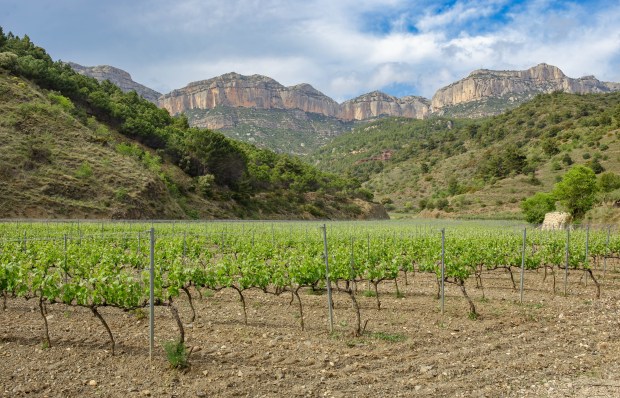Lenten Campaign 2025
This content is free of charge, as are all our articles.
Support us with a donation that is tax-deductible and enable us to continue to reach millions of readers.
The Carthusian order was founded in the late 11th century in the French Prealps by Bruno de Cologne. By the end of the next century, as northern Spain was being reconquered and the territory needed to be repopulated, Carthusians arrived in the Peninsula for the very first time. Their first monastery was the imposing Cartoixa D’Escaladei, the Carthusian Monastery of St. Mary of Escaladei – Escaladei being a phonetic corruption of the original Latin Scala Dei, “the ladder of God,” or even “the ladder unto God.”
Founded in 1194 by Alfonso II of Aragón, the Escaladei Charterhouse soon became a local center of economic, political, and spiritual power. The area, a renowned wine-producing region, is still known as El Priorat – Catalan for “the Priory,” in a straightforward reference to this monastery. Around the 13th century, having received royal protection and important donations from King Jaume I (“the Conqueror”), Escaladei acquired not only great prestige, but legal feudal jurisdiction over the neighboring towns and lands – the same region still known today as El Priorat. The Prior of the monastery decided where the vineyards were to be planted, and the monks received a tenth part of all the grapes grown in the area through tithe.
The Charterhouse
The first part of the monastery corresponds to the transition period between Romanesque and Gothic styles. In that sense, the older remains of the monastery provide the visitor with a unique perspective of medieval architectonical developments. This first section of the cloister, which was completed in in 1228, includes a church dedicated to Our Lady, 12 cells (for the 12 monks originally living there), and the other basic dependencies of any monastery: a chapter house (where monks would meet to discuss everyday matters related to the administration of the monastery and its surrounding lands), the refectory, and a chapel. Right outside of that cloister, one would find the service dependencies, including pharmacies and infirmaries. Some of these remains are still standing.

Later, in 1333, the second cloister was built (this one in full Gothic style) including 12 more cells, doubling the capacity of the monastery. Some 70 years later, further donations from local nobility allowed the monks to build a third cloister with six more cells. One of these cells has been entirely rebuilt (personal medicinal herb garden included), so that visitors can see how late-medieval Carthusian monks lived.
Reforms to the monastery began in the late 16th century and continued throughout the 17th and 18th centuries, which ended up conferring an overall Baroque and neo-classicist style to the Charterhouse. It was during this period when Escaladei became not only a focus of economic and political power, but also of fine culture and art, especially because of the works of Joaquim Juncosa i Domadel, a Carthusian monk himself, who started the so-called Escaladei School of painting.

As with most Spanish monasteries, as the Spanish Confiscation began the monastic community of Escaladei was dissolved, and its lordship over the Priorat revoked. Most of the cloister was sacked and burned down. Whatever survived the looting was auctioned, including the surrounding lands. Some of the monastery’s remains were looted to be used as second-hand building material.
Restoration works have brought to light part of its ancient splendor, as the Carthusian ruins have been declared a national patrimonial asset. The local Catalonian government acquired the complex from its former owners in 1989. Since then, the ruins of Escaladei are open to public visits.
Who are the Carthusians
The Carthusians are monks consecrated to prayer in solitude and silence, hermits who live in community under the vows of poverty, chastity, obedience and silence, and guided by a prior. Depending on whether they are priests or brothers, they serve the community in different ways.
Carthusian priests live in their cells, and devote themselves to prayer, reading, meditation, contemplation and manual work. A typical Carthusian priest meets the other monks three times a day to celebrate common services, but would share a meal together with them in the refectory on Sundays and holidays. A Carthusian brother, although also monk, would spend six hours a day doing manual work, yet outside his cell – mainly caring for the internal maintenance of the monastery.
If you want to know more about the Carthusians, you can read Phil Kosloski’s brief guide to the Order of Saint Bruno here.
God’s Ladder: The Montsant
El Priorat, as a wine-growing area, arose when these monks settled in the province of Tarragona at the request of Alfonso II. Local legends claim that, as they were crossing the Sierra del Montsant (Catalan for “Holy Mountain”), they met a shepherd who told them he saw some angels who were climbing the steep cliffs of the mountain range using a ladder that went all the way up to the clouds. The monks saw this as a sign from God, the shepherd’s story resembling that of Jacob’s ladder (Gen. 28:11-19). They thus decided to build their charterhouse there, and call it Scala Dei, “God’s Ladder.”

Currently, El Priorat attracts tourists from all over the world, due to its mountain landscape, famous wines, charming towns (most of them not even 1 hour away from the sea), its many medieval hermitages and chapels, and its remarkable gastronomy. Nearby towns have recently became free climbing hot spots – exactly what one would expect from a divine ladder.











